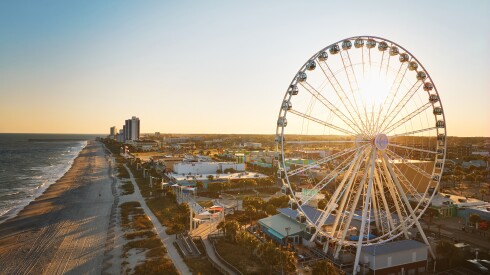The Grand Canyon National Park’s North Rim, often described as the park’s quieter, wilder side, is now closed indefinitely following a fast-moving wildfire that has engulfed more than 8,500 acres and destroyed dozens of structures, including one of the park’s most beloved landmarks, the historic Grand Canyon Lodge.
The Dragon Bravo fire, ignited by lightning on July 4 and fueled by persistent winds and drought conditions, swept through the park’s North Rim this week, consuming more than 50 structures, including cabins, park administrative offices, visitor centers, and a water treatment facility, and forcing the evacuation of visitors and staff. As of press time, the Dragon Bravo fire has zero percent containment, as does the White Sage fire, which began on Wednesday, July 9, and has burned more than 50,000 acres in and around the nearby Kaibab National Forest. According to the National Park Service, no injuries or deaths were reported with everyone in the area successfully evacuated ahead of time.
All North Rim operations—including campgrounds, backcountry access, and trails such as the North Kaibab—are closed and will remain so for the rest of the 2025 season, per the National Park Service. Here’s what travelers need to know if they plan to visit the Grand Canyon in the second half of 2025.

The lesser-visited North Rim area of Grand Canyon National Park is closed indefinitely due to fires.
Photo by Dusty Roads/Shutterstock
Grand Canyon Lodge lost
One of the most significant losses thus far is the Grand Canyon Lodge, a stone-and-timber icon perched just feet from the canyon’s edge and a beloved fixture of rim-to-rim hikes, family road trips, and national park nostalgia.
Built in 1928 and rebuilt after a kitchen fire in 1932, the lodge was the only full-service hotel on the North Rim and a designated National Historic Landmark. Built with giant ponderosa pines, it was known for its sweeping canyon views from the sunroom, its massive fireplace in the lounge, and its rows of rustic cabins in the surrounding forest.
“As stewards of some of our country’s most beloved national treasures, we are devastated by the loss of the Grand Canyon Lodge and numerous other historic buildings at the Grand Canyon’s North Rim,” Aramark Destinations, the concessionaire that operates Grand Canyon Lodge, said in a statement on its website. “We are grateful that all our employees and guests have been safely evacuated, and we join the National Park Service in mourning the loss of these iconic and beloved structures.”
Aramark added: “For those with upcoming reservations, our teams will be reaching out within the next 24 hours with details about cancellations and next steps.”
The full extent of the damage is still being assessed, and fire containment remains a challenge as high winds and dry conditions persist.

As of press time, Phantom Ranch at the bottom of Grand Canyon remained closed as authorities assessed the area.
Photo by Fredlyfish4/Shutterstock
North Rim and parts of the bottom of the Grand Canyon closed
All visitor services on the North Rim, which draws about 10 percent of the Grand Canyon’s roughly 5 million annual visitors according to park officials, are suspended until further notice. This includes lodging, dining facilities, gas stations, the North Rim Visitor Center, the North Rim campground, and ranger programs.
Travelers who have already booked a visit to the North Rim for this summer should contact the operator about rebooking and refund options. (Already, operators such as Aramark and the National Park Service have reportedly reached out to affected guests.)
Inner-canyon trails, such as the North and South Kaibab Trails, are also affected by the closure. Similarly, rim-to-rim hikes that start or end on the North Rim—typically popular in late summer and fall—are no longer possible for the rest of the season. Because the North Rim’s season runs from May 15 through October 15 annually, the area is not likely to reopen until May 2026.
According to the National Park Service, Phantom Ranch, the only lodging at the bottom of the Grand Canyon, is also closed because a water treatment plant was damaged in the fire and leaked chlorine gas (exposure to it can cause lung damage and in high concentrations, death) that could have quickly settled into the lower canyon. (A stay at the ranch requires winning a lottery more than a year in advance.) Xanterra Travel Collection, which operates Phantom Ranch, said the property will remain closed until an assessment of the area is complete. Bright Angel Trail below Havasupai Garden is also closed until further notice.
South Rim remains open
At this time, the South Rim remains open and unaffected by the fire. If your trip can be rerouted, the South Rim offers ample opportunities to explore the canyon safely. Roads, visitor centers, lodges, campgrounds, and day hiking trails are unaffected by the fires, although haze and smoke may be visible on some days depending on wind direction. (You can check the Grand Canyon NPS alerts page for updates on visibility or air quality before your visit, too.) Ranger programs and visitor centers on the South Rim are in full operation, with talks, stargazing events, and cultural history exhibits continuing to take place at the Grand Canyon Visitor Center and Yavapai Geology Museum.
There are currently myriad lodging options on the South Rim, including the historic El Tovar Hotel, Bright Angel Lodge, Kachina and Thunderbird Lodges, and Maswik Lodge. That said, it’s a good idea to book early—availability may tighten as displaced North Rim visitors shift plans.








